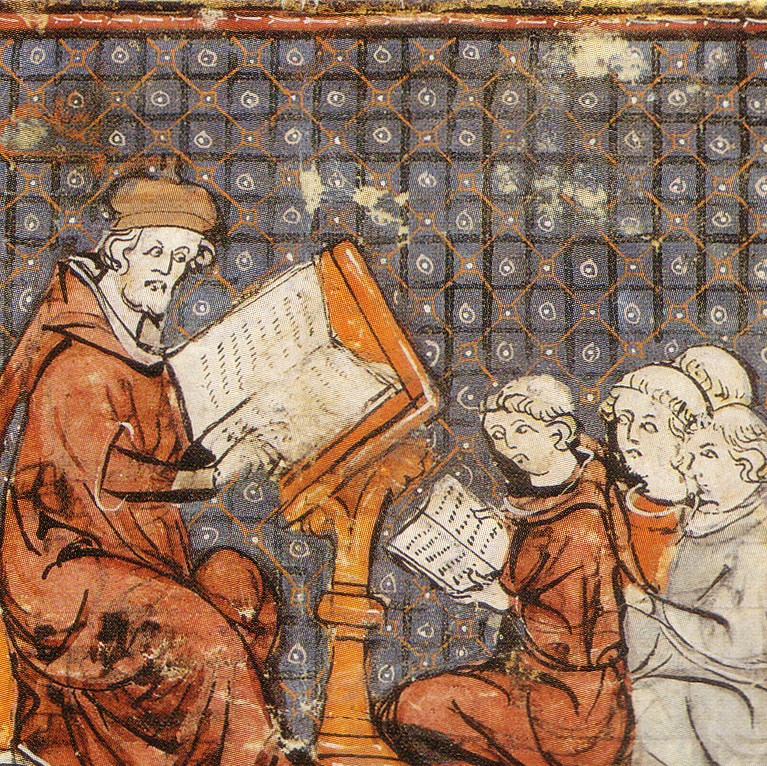The equinox is upon us and, following the rhythm established in the Middle Ages, a new university year begins. Between the thirteenth and sixteenth centuries the various orders of monks, canons and friars had a notable presence at Oxford and Cambridge, shaping not only the intellectual life of the universities but also leaving a lasting architectural legacy. And, as I’ll explain, the activities of medieval monastic scholars have more than a little in common with their modern-day secular counterparts.
From their earliest days, English monasteries were engaged in advanced scholarship. The school at St Augustine Abbey, Canterbury, for instance, was famous across early medieval Europe. But the monastic monopoly on higher education was overturned by the emergence of the universities. Oxford was firmly established by 1167 and Cambridge in the 1230, both with privileges and degree awarding powers confirmed by kings, popes and prelates.
Benedictine monks were among the early graduates of universities. But it was the friars – the religious orders dedicated to preaching and ministering to the spiritual and physical needs of Christ’s poor – who first established bases at the English universities.
Dominican and Franciscan friaries were founded in Oxford in the 1220s and in Cambridge a decade later. The Augustinians and Carmelites subsequently joined them. Friars in the university towns rapidly established a formidable reputation for scholarship. The Franciscans in Oxford, for instance, were renowned for their instruction in Greek, Hebrew and even Arabic. Their friary was home to the eminent 13th-century scholars Richard Rufus and Roger Bacon.
By the time of Bacon’s death in c.1291, the monastic orders were also establishing a permanent presence at the universities. By the end of the Middle Ages, there were no fewer than three Oxford colleges for Benedictine monks (Gloucester College, Durham College and Canterbury College) and one each for the Cistercians (St Bernard’s College) and Augustinian canons (St Mary’s College). Adding to their number was Beaumont College, Cambridge, founded in the early 15th century for Benedictine monks.
In the 1330s Pope Benedict XII, who had previously been a scholar-monk at the Sorbonne, issued a series of papal bulls demanding that monasteries should send one in every 20 of their monks to university. If evidence from Durham is anything to go by, scholarly young monks were talent-spotted soon after entering the cloister. Those “apt to lernyng” and possessed of “a pregnant wyt withal” were “sent to oxforde”.
Once matriculated, monkish scholars had to divide their time between a modified monastic timetable of regular religious services and strenuous study. It took up to seven years to obtain the degree of Bachelor of Divinity, with three more years of hard academic graft needed for a Masters. The degree of Doctor of Divinity was awarded after seven additional years of reading and academic disputation, or debate. To obtain this prized academic distinction, candidates at Oxford were required to lecture on both the Bible and the Sentences of Peter Lombard (the standard university text book of the day), deliver a sermon at the university church of St Mary the Virgin and debate with all seven of the university’s governing regents. Writing a PhD thesis seems like a doddle in comparison. It’s easy to understand why graduate monks made sure their brethren, and anyone else for that matter, were aware of their scholarly credentials. John Greenwell, abbot of Fountains in the mid-15th century, was even depicted on his grave slab with his pontifical mitre elevated about his head so that everyone could see that he had the right to wear a doctoral cap.
Then as now, a university education didn’t come cheap. Maintenance of a single monastic scholar cost between £5 and £10 a year. Some monasteries couldn’t afford this expenditure. Muchelney Abbey (Somerset) was admonished on more than one occasion for leaving its rooms at Gloucester College unoccupied.
There was also a reluctance to contribute to the maintenance of college buildings. St Bernard’s College was founded for Cistercian scholars in the 1430s on land given by Archbishop Chichele of Canterbury. It was left to the order’s abbeys to pay for the college buildings. Lack of funds meant their construction was glacially slow and the unfinished quadrangle was condemned as bringing “shame” on the order.
The notebooks of Worcester monks who studied at Oxford in the 14th century provide gleanings about student life. Their pages are packed with lecture notes, annotated sermons and preparatory notes for the disputations which were at the heart of the university curriculum. Monks built up personal libraries to assist in their studies, and a significant proportion of surviving monastic books have inscriptions recording their purchase by monks studying at the universities.
Student monks were sometimes as impecunious as their modern contemporaries and even resorted to pawning their books to raise some ready cash. Some also built up formidable debts. Those accrued by one Brother Thomas Hosyntre took his monastery years to pay off.
It’s also clear that not every monk made the most of the scholarly opportunities afforded by going up to university. In the 1480s, the warden of Canterbury College was incensed by the conduct of some young monks from Peterborough Abbey who, he angrily asserted, were not “gydid as scolerys shuld be, for they be noo studentys”. In the early 16th century a “Mr Rievaulx” (the monastery’s future abbot, Edward Kirby) received a sound telling off for his carousing and debauchery.
Youthful indiscretions weren’t restricted to drinking and partying. University study could expose monks to dangerous opinions. While at Oxford in the late 14th century, the Byland monk Geoffrey Pickering became an adherent of John Wycliffe, whose proto-Protestant writings were condemned as heretical. But Pickering rapidly distanced himself from these opinions, and after reaffirming his theological orthodoxy was elected abbot of his Yorkshire monastery. Then as now, a university degree was a passport to career advancement.
Monks also made a major contribution to university life. William Rimington, a monk of Sawley Abbey, served as Chancellor of Oxford at the end of the 14th century, his erudition evident in his surviving sermons. Despite being integral to the universities, the monastic colleges were dissolved during the reign of Henry VIII. Fragments of their buildings remain at the several post-medieval Oxford colleges, including St John’s, Trinity and Worcester and also at Magdalene College, Cambridge. Friars and monks returned to the universities in the nineteenth and twentieth centuries, and to this day keep alive scholarly traditions established by their medieval predecessors.



 Loading ...
Loading ...
What do you think?
You can post as a subscriber user ...
User comments (1)